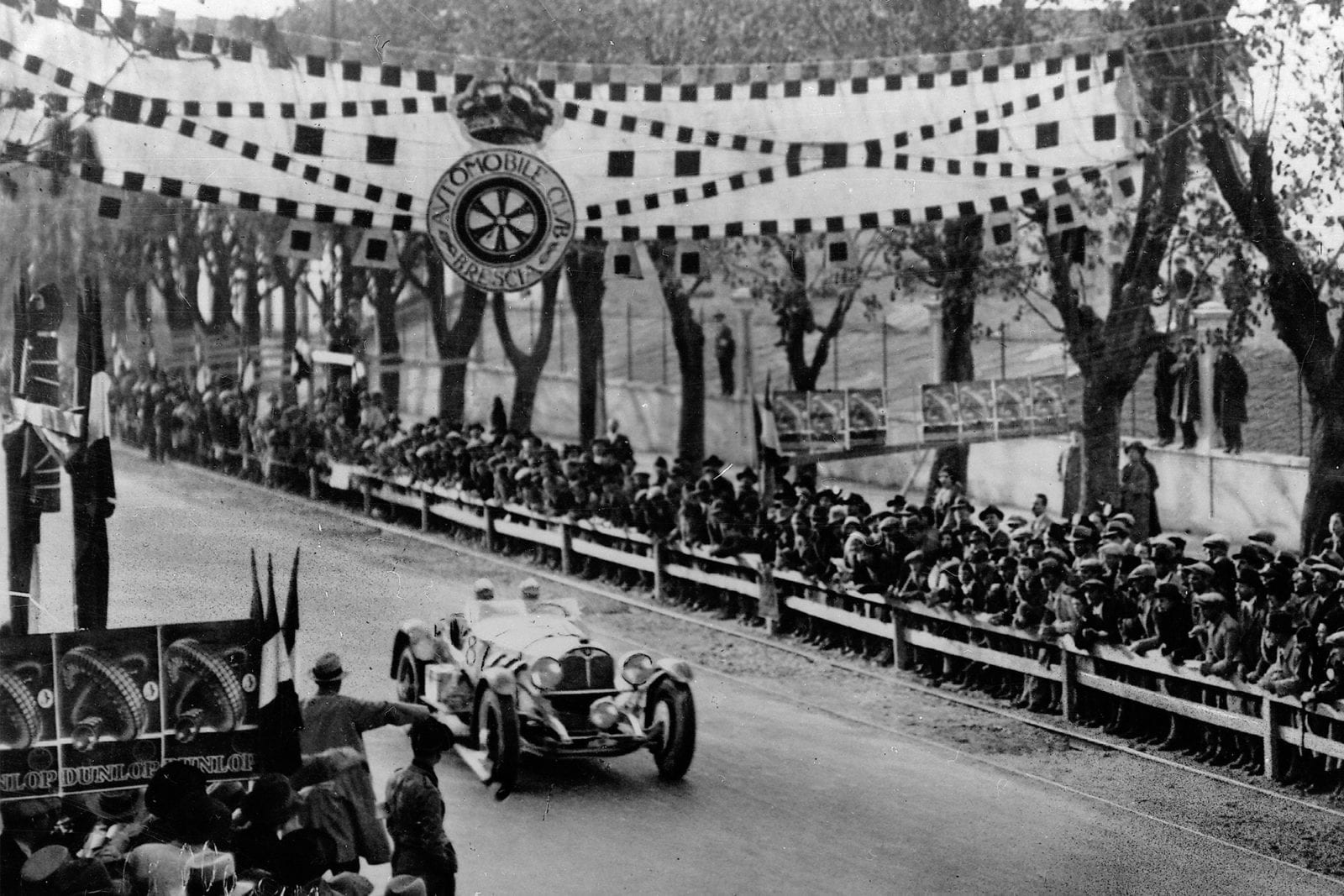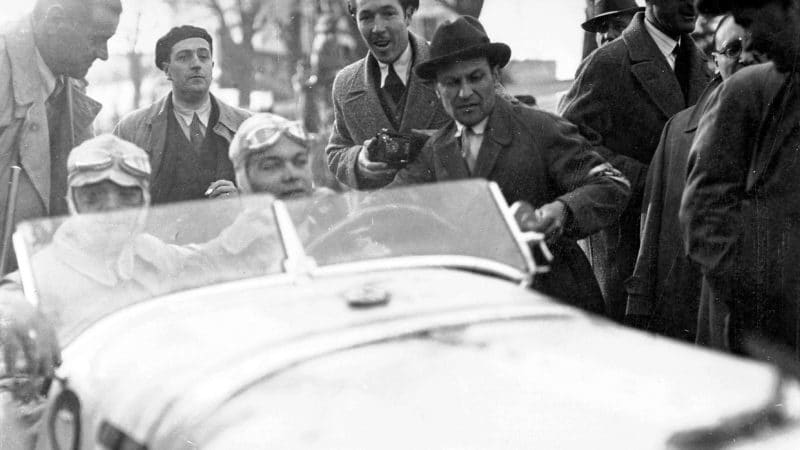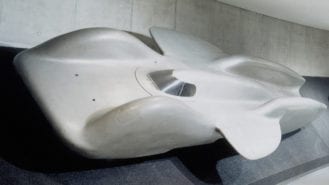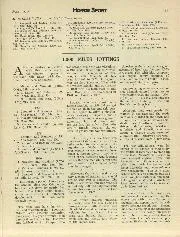At Cremona, some thirty miles from Brescia, Caracciola led, at Parma he was still in the lead and had covered 115 kilometres at over 95 m.p.h., Reggio still saw him ahead, and finally he roared into Bologna, having covered the first 128 miles of the race in 1 hour 21 minutes, or at an average of 95.7 m.p.h., and had beaten last year’s record set up by Arcangeli on a Maserati by eight minutes. The Italians had evidently got to fight hard, and already their chief hope, the new Alfa Romeos, had begun to suffer from tyre troubles. Arcangeli’s car had cast two treads on the way to Bologna, and it was Morandi and Rosa on the 6-cylinder side-valve O.M, who were second seven minutes behind the Mercedes, with Campari third on the 1,750 c.c. Alfa in 1 hour 29 minutes, Nuvolari on the first of the straight-eights fourth in 1 hour 30 minutes with Borzacchini and Arcangeli fifth and sixth.
Almost as soon as Bologna is left the road enters to Apennines, and in some thirty miles climbs to the wild summit of the Raticosa Pass and then drops down before climbing again to the Mita Pass whence starts the descent into Florence. It was on this section that the smaller cars hoped to catch the big Mercedes, but at Florence Caracciola still led, and Nuvolari on the big Alfa had moved up into second place. The order at this point, after some 200 miles was as follows :—
1. Caracciola (Mercedes), 2h. 45m.
2. Nuvolari (Alfa-Romeo), 2h. 50m.
3. Morandi (0.M.), 2h. 51m.
4. Campari (Alfa-Romeo), 2h. 52m.
5. Arcangeli (Alfa-Romeo), 2h. 58m.
In the 1,100 cc. class Tufanelli on the Maserati was leading, but the little Austin was running second and arousing universal admiration.
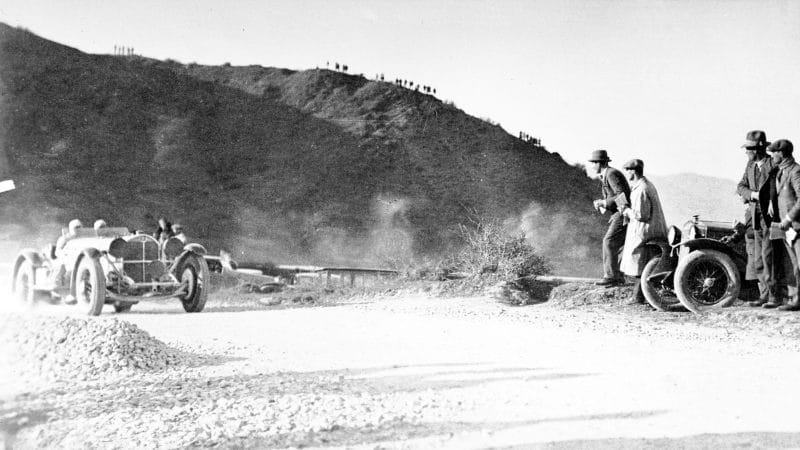
Cracciola kept his lead in the mountains — at least while the sun shone
Mrcedes-Benz
From Florence to Rome the road is again mountainous, but as far as Sienna, Caracciola still held the lead, and Nuvolari was still some five minutes behind. As they were sent away again, darkness was falling, and its effect on the race was immediate. There was no doubt that Caracciola was happier in the light, but the Italians did not seem to mind the darkness in the least and on the winding roads leading into Rome, Nuvolari passed the German and took the lead. The order when the capital was reached after 372 miles was thus as follows :
1. Nuvolari (2,300 c.c. Alfa-Romeo). 6h. 1m. 49s. (Average speed 62.5 m.p.h.).
2. Caracciola (Mercedes), 6h. 3m.
3. Campari (1,750 c.c. Alfa-Romeo), 6h. 6m.
4. Borzacchini (1,750 c.c. Alfa-Romeo), 6h. 8m.
5. Arcangeli (2,300 c.c. Alfa-Romeo), 6h. 11m.
6. Morandi (O.M.).
Between Brescia and Rome, Arcangeli and his mechanic had changed nine tyres and in the capital it was decided to change over to Dunlops. Then in the darkness the cars were despatched once more for the second crossing of the Apennines, this time from West to East. In this night-time crossing of the mountains the particular ability of Borzacchini began to be shown, and he worked his way up until he had passed Nuvolari, who like Arcangeli had begun to suffer from tyre troubles. At Terni, some 440 miles from Brescia, he held the lead and Caracciola was falling steadily back at Spoleto; some 455 miles from the start the order was as follows:
1. Borzacchini (1,750 c.c. Alfa-Romeo).
2. Campari (1,750 c.c. Alfa-Romeo).
3. Arcangeli (2,300 c.c. Alfa-Romeo).
4. Morandi (O.M.).
5. Nuvolari (2,300 c.c. Alfa-Romeo).
6. Caracciola (Mercedes).
Now it was Campari’s turn, and on the next stage he passed Borzacchini to take the lead, the latter continued to fall back and Caracciola was working his way up again. At Ancona on the Adriatic, after 583 miles of the race had been covered, the order was as follows :
1. Campari (Alfa-Romeo).
2. Arcangeli (Alfa-Romeo).
3. Caracciola (Mercedes).
4. Borzacchini (Alfa-Romeo).
5. Nuvolari (Alfa-Romeo).
6. Morandi (O.M.).
From Ancona the road runs Northwards, dead straight along the shores of the Adriatic, and it was here that Arcangeli began to use the full power of his straight-eight Alfa. He passed Campari to take the lead in the race, and when Bologna was reached for the second time, after 752 miles of the race had been covered, the order was as follows :
1. Arcangeli (Alfa-Romeo), 12h. 7m. (Average speed 62.1 m.p.h.).
2. Campari (Alfa-Romeo), 12h. 12m.
3. Caracciola (Mercedes), 12h. 15m.
4. Borzacchini (Alfa-Romeo), 12h. 20m.
5. Morandi (O.M.), 12h. 27m.
6. Nuvolari (Alfa-Romeo), 12h. 29m.
